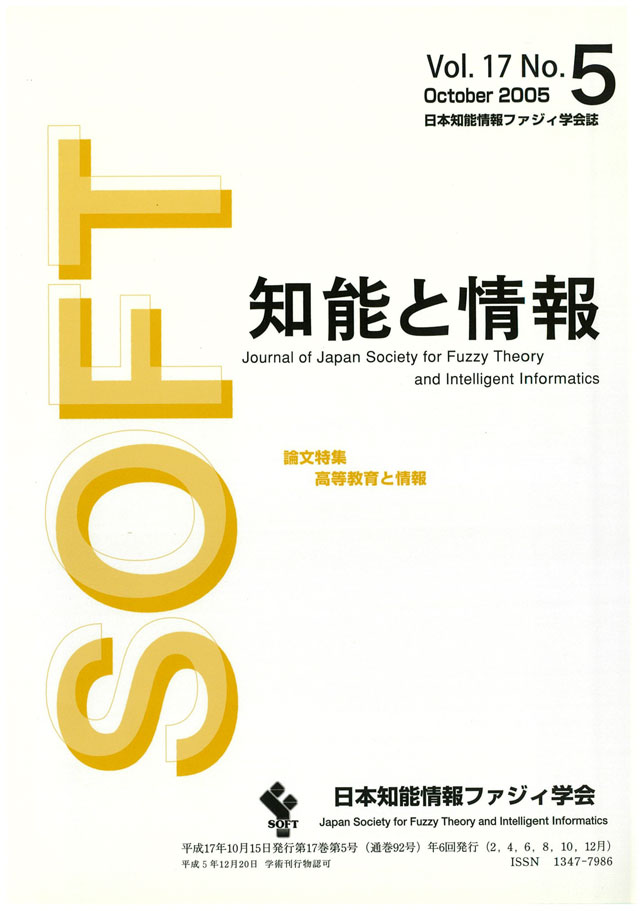Volume 17, Issue 5
Displaying 1-25 of 25 articles from this issue
- |<
- <
- 1
- >
- >|
-
Article type: Index
2005Volume 17Issue 5 Pages Toc5-
Published: October 15, 2005
Released on J-STAGE: December 19, 2017
Download PDF (69K)
-
Article type: Article
2005Volume 17Issue 5 Pages 515-
Published: October 15, 2005
Released on J-STAGE: May 02, 2017
Download PDF (153K)
-
Article type: Article
2005Volume 17Issue 5 Pages 516-
Published: October 15, 2005
Released on J-STAGE: May 02, 2017
Download PDF (153K)
-
Article type: Article
2005Volume 17Issue 5 Pages 517-524
Published: October 15, 2005
Released on J-STAGE: May 02, 2017
Download PDF (1140K)
Special
Original Papers
-
Article type: Article
2005Volume 17Issue 5 Pages 525-535
Published: October 15, 2005
Released on J-STAGE: May 02, 2017
Download PDF (1339K) -
Article type: Article
2005Volume 17Issue 5 Pages 536-546
Published: October 15, 2005
Released on J-STAGE: May 02, 2017
Download PDF (1409K) -
Article type: Article
2005Volume 17Issue 5 Pages 547-557
Published: October 15, 2005
Released on J-STAGE: May 02, 2017
Download PDF (1693K) -
Article type: Article
2005Volume 17Issue 5 Pages 558-568
Published: October 15, 2005
Released on J-STAGE: May 02, 2017
Download PDF (1283K) -
Article type: Article
2005Volume 17Issue 5 Pages 569-586
Published: October 15, 2005
Released on J-STAGE: May 02, 2017
Download PDF (2176K)
R & D Papers
-
Article type: Article
2005Volume 17Issue 5 Pages 587-598
Published: October 15, 2005
Released on J-STAGE: May 02, 2017
Download PDF (1586K)
Short Notes
-
Article type: Article
2005Volume 17Issue 5 Pages 599-606
Published: October 15, 2005
Released on J-STAGE: May 02, 2017
Download PDF (827K)
-
Article type: Article
2005Volume 17Issue 5 Pages 607-608
Published: October 15, 2005
Released on J-STAGE: May 02, 2017
Download PDF (210K) -
Article type: Article
2005Volume 17Issue 5 Pages 609-610
Published: October 15, 2005
Released on J-STAGE: May 02, 2017
Download PDF (379K)
-
Article type: Article
2005Volume 17Issue 5 Pages 611-
Published: October 15, 2005
Released on J-STAGE: May 02, 2017
Download PDF (164K)
-
Article type: Article
2005Volume 17Issue 5 Pages 612-
Published: October 15, 2005
Released on J-STAGE: May 02, 2017
Download PDF (172K) -
Article type: Article
2005Volume 17Issue 5 Pages 612-
Published: October 15, 2005
Released on J-STAGE: May 02, 2017
Download PDF (172K)
-
Article type: Article
2005Volume 17Issue 5 Pages 613-
Published: October 15, 2005
Released on J-STAGE: May 02, 2017
Download PDF (205K)
-
Article type: Article
2005Volume 17Issue 5 Pages 614-
Published: October 15, 2005
Released on J-STAGE: May 02, 2017
Download PDF (137K) -
Article type: Article
2005Volume 17Issue 5 Pages 614-
Published: October 15, 2005
Released on J-STAGE: May 02, 2017
Download PDF (137K)
Regular
Original Papers
-
Article type: Article
2005Volume 17Issue 5 Pages 615-621
Published: October 15, 2005
Released on J-STAGE: May 02, 2017
Download PDF (873K) -
Article type: Article
2005Volume 17Issue 5 Pages 622-630
Published: October 15, 2005
Released on J-STAGE: May 02, 2017
Download PDF (984K) -
Article type: Article
2005Volume 17Issue 5 Pages 631-640
Published: October 15, 2005
Released on J-STAGE: May 02, 2017
Download PDF (1111K)
-
Article type: Appendix
2005Volume 17Issue 5 Pages 642-
Published: October 15, 2005
Released on J-STAGE: May 02, 2017
Download PDF (61K) -
Article type: Appendix
2005Volume 17Issue 5 Pages 642-
Published: October 15, 2005
Released on J-STAGE: May 02, 2017
Download PDF (61K)
-
Article type: Appendix
2005Volume 17Issue 5 Pages A1-A10
Published: October 15, 2005
Released on J-STAGE: May 02, 2017
Download PDF (579K)
- |<
- <
- 1
- >
- >|
